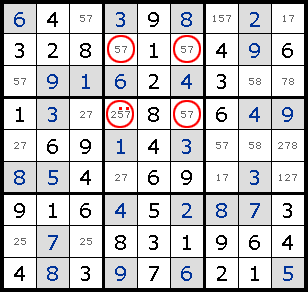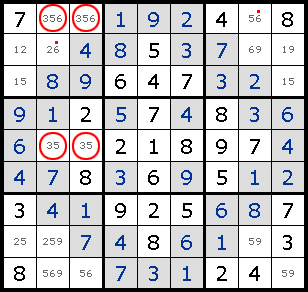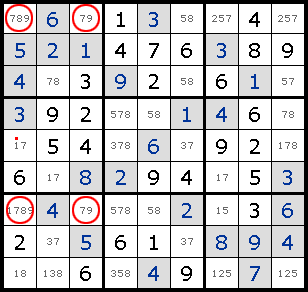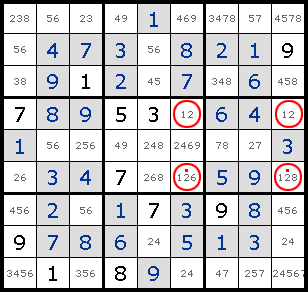Read the Sudoku help page for the rules, and the techniques potentially required to solve BrainBashers Sudoku.
Unique Rectangles is an advanced technique. Its name comes from a collection of two locked pairs that form a rectangle. Every Sudoku has to have a unique answer, we are not allowed to create a situation where this rule is violated. We need to look for four squares that share exactly two rows, two columns and two blocks, if we had a Sudoku with a non-unique answer, then we could swap the digits and still have a valid Sudoku with no duplicates. The examples below are a subset of the logic which can be deduced from the requirement of uniqueness, if you come across a situation which looks similar, then carefully think about the implications of the Sudoku being left in an invalid state.
Note: the squares have to share exactly two rows, two columns *and* two blocks.

There are almost two occurrences of a locked pair in <57>. However, we can never end up with all four squares only containing <57> otherwise we could swap the <5> & <7> and still have a valid answer, which is not allowed. Therefore <5> & <7> can be removed from R4C4.
This is a little tricky to understand, but if R4C4 was a <5> then the other three squares would be known, but we could then swap the <5> & <7> in these squares, which would give the Sudoku multiple answers. Similarly, R4C4 cannot be a <7> either.

There are almost two occurrences of a locked pair in <35>. However, we can never end up with all four squares only containing <35> otherwise we could swap the <3> & <5> and still have a valid answer, which is not allowed. Therefore the <6> in R1 must be in either R1C2 or R1C3 and can therefore be removed from R1C8 and R2C2.

There are almost two occurrences of a locked pair in <79>. However, we can never end up with all four squares only containing <79> otherwise we could swap the <7> & <9> and still have a valid answer, which is not allowed. Therefore, one of the values <1> or <8> must appear in one of R1C1 or R7C1, but we don't know which square, nor which digit. But we can treat R1C1 and R7C1 as a pseudo-single square (i.e. it contains either <1> or <8>) and look for a locked set containing <18> . We therefore have a locked set of <18> in C1 and can remove the <1> from R5C1.
Note: the pseudo-single square can contain more than two additional digits, but we'd then have a locked set over three squares, etc.

There are almost two occurrences of a locked pair in <12>. However, we can never end up with all four squares only containing <12> otherwise we could swap the <1> & <2> and still have a valid answer, which is not allowed. The <1> in R6 must be in either R6C6 or R6C9, therefore the <2> cannot also be in either of these squares, and therefore it can be removed.
A small warning, by dealing with a Type 4 rectangle, you effectively destroy this type of check, so check for other types of Unique Rectangle first.
Note: BrainBashers has a Dark Mode option. For BrainBashers, I'd recommend not using your browser's built-in dark mode, or any dark mode extensions (sometimes you can add an exception for a specific website).